Arkansas Fruit Breeding Program Releases New Late-Season Blackberry
Sweet-Ark® ImmaculateTM is a new thornless blackberry from Arkansas program
By John Lovett– Feb. 7, 2024

NEW BERRIES — A new thornless, floricane blackberry has been released by the Arkansas Fruit Breeding Program. (U of A System Division of Agriculture photo by Paden Johnson)
FAYETTEVILLE, Ark. — The Arkansas Fruit Breeding Program has released a new late-season blackberry to give growers a premium product after other varieties are done yielding.
Commercial scale propagators have licenses and material for sale for the 2024 planting season.
Sweet-Ark® ImmaculateTM is a thornless, floricane-fruiting blackberry that offers medium to large berries that have been shown to hold up well after harvest. Floricane varieties produce flowers and fruit on second year canes.
“It is named to highlight its berry quality, which is beyond reproach, and its late-ripening season,” said Margaret Worthington, director of the Fruit Breeding Program for the Arkansas Agricultural Experiment Station. “People have been asking about a new late-season variety from the Arkansas program for a long time now. The main advantages Sweet-Ark® ImmaculateTM has over other late-season blackberry varieties are its outstanding post-harvest performance and its great yield potential.”
The experiment station is the research arm of the University of Arkansas System Division of Agriculture.
Worthington said Sweet-Ark® ImmaculateTM demonstrates a step forward for blackberry firmness, which aids in holding up well during storage and shipping. Post-harvest trials at the Fruit Research Station near Clarksville show that Sweet-Ark® Immaculate had better fruit firmness than all comparison cultivars after two weeks of refrigerated storage.
Maintaining quality in post-harvest storage is especially challenging late in the season, Worthington added, because it is when temperatures are high and spotted wing drosophila pest pressure increases.
Despite its late-ripening window, red drupelet reversion and leak ratings for Sweet-Ark® Immaculate TM were similar to earlier season varieties like Sweet-Ark® Caddo and Sweet-Ark® Ponca, she noted. Red drupelet reversion occurs when the individual round segments on the blackberry turn from black back to red during or after postharvest storage.
HARVEST TIME — Sweet-Ark® Immaculate™ is typically ready to pick the last week of June through mid-to-late July at the Fruit Research Station near Clarksville. (U of A System Division of Agriculture photo by Paden Johnson)
Late-season love
Late-season varieties are treasured for growers in the shipping industry to command a higher premium because less fruit is available during that period. But, she said, it is also nice for local growers who can have fruit available at farmers markets, fruit stands, or pick-your-own operations later in the season.
At the Fruit Research Station, Sweet-Ark® ImmaculateTM is typically ready to pick the last week of June through mid-to-late July. Worthington noted that this period is 10 to 14 days after the harvest of Ouachita but in season with Navaho and Von.
Like Sweet-Ark® Ponca, Sweet-Ark® ImmaculateTM has shorter-than-standard canes and a reduced space between leaves, also known as the internode length.
“It fills the trellis, but the first-year canes are a little bit shorter than standard,” Worthington said. “This has an advantage for growers because you don’t have to tip during the busy season when harvesting fruit. So, it can spread out the workload a little bit.”
The term “tipping” refers to summer pruning on new blackberry canes performed during the growing season to manage plant height and increase yields by promoting lateral branching.
Including Sweet-Ark® ImmaculateTM, the Arkansas Fruit Breeding Program has publicly released 22 blackberry varieties, with 16 of those being floricane fruiting.
Sweet-Ark® Immaculate™ is available for licensing to propagators. Contact the Technology Commercialization Office for licensing information at 479-575-3953 or by email at agritco@uada.edu.
To learn more about the Division of Agriculture research, visit the Arkansas Agricultural Experiment Station website. Follow us on 𝕏 at @ArkAgResearch, subscribe to the Food, Farms and Forests podcast and sign up for our monthly newsletter, the Arkansas Agricultural Research Report. To learn more about the Division of Agriculture, visit uada.edu. Follow us on 𝕏 at @AgInArk. To learn about extension programs in Arkansas, contact your local Cooperative Extension Service agent or visit uaex.uada.edu.
About the Division of Agriculture
The University of Arkansas System Division of Agriculture’s mission is to strengthen agriculture, communities, and families by connecting trusted research to the adoption of best practices. Through the Agricultural Experiment Station and the Cooperative Extension Service, the Division of Agriculture conducts research and extension work within the nation’s historic land grant education system.
The Division of Agriculture is one of 20 entities within the University of Arkansas System. It has offices in all 75 counties in Arkansas and faculty on three campuses.
Pursuant to 7 CFR § 15.3, the University of Arkansas System Division of Agriculture offers all its Extension and Research programs and services (including employment) without regard to race, color, sex, national origin, religion, age, disability, marital or veteran status, genetic information, sexual preference, pregnancy or any other legally protected status, and is an equal opportunity institution.




